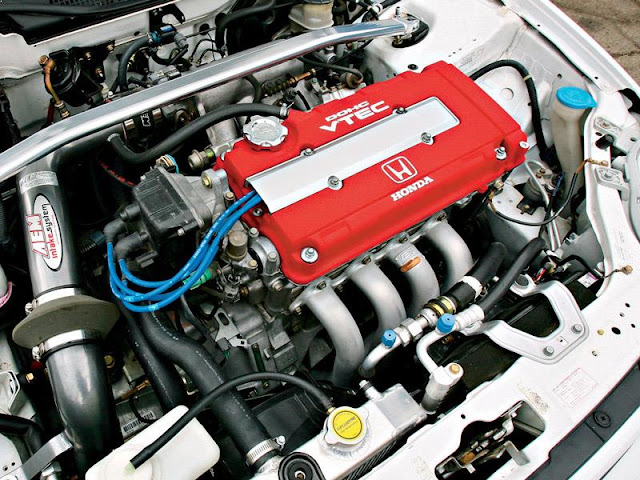Honda's B18C5 or also know like the Master of the VTEC engine
We already know that: The B-series are a family of inline four-cylinder DOHC automotive engines introduced by Honda in 1989. Sold concurrently with the D-series which were primarily SOHC engines designed for more economical applications, the B-series were aimed more as a performance option, featuring dual-overhead cams along with the first application of Honda's VTEC system available in some models.
The B-series, the B20B variant in particular, is not to be confused with the earlier Honda B20A engine introduced in 1985 and primarily available in the Prelude and Accord-derived vehicles from 1985-1991. While sharing some design elements and both being multivalve Honda four-cylinders, the B-series and B20A differ substantially in architecture, enough to be considered distinct engine families.
But this engine is popular and it has lots of JDM factor, if that’s something you are into. The ease in which the B series engine can be swapped into a Civic is frankly ridiculous, for a guide on how to swap a B series, check here.
If you want to bolt it in and go without bothering to modify or improve the engine’s performance, the B18C5 is the way to go. No need to mess with cam profiles or cam gears, simply installing a Type R engine will radically transform your Honda Civic.
Beware -It’s not cheap and in fact it’s still prohibitively expensive to swap a true B18C5.With the amount of normal B18a, B18B and B18C1 engines out there, it wouldn’t be financially wise to jump straight to the B18C5.VTEC / 195 PS/ 1797cc / 176 N·m / stock performance
Found in: USDM/CDM DC2 Acura Integra Type-R (Integra Type-R)1997, 1998, 2000, 2001 Integra Type-R (Note:1997-2001 CDM)Displacement: 1,797 cc (109.7 cu in)Compression: 10.6:1Bore: 81 mm (3.2 in)Stroke: 87.2 mm (3.4 in)Rod Length: 137.9 mm (5.4 in)Rod/Stroke Ratio: 1.58Power: 195 hp (145 kW) @ 8000 rpm & 130 lb·ft (176 N·m) @ 7500 rpmRedline: 8400rpm (Fuel cut-off @ 8500rpm)VTEC Engagement @ 5500 rpmTransmission: S80 w/LSd
F20C and Honda S2K
Efficiency to the Max! / 250 PS/ 1997cc / 218 N·m / stock performance
The F20C and F22C1 are inline-4 engines produced by Honda. They are one of the few Honda 4-cylinder automobile engines that are designed to sit longitudinally for rear wheel drive.
These engines are a distant relative to the F-series engines found in the mid 90s Honda Accord and Prelude. To get most out of the compact sized engine, Honda engineers utilized technology derived from Honda's racing engines. The F20C and F22C1 have two overhead cams with roller followers, a ladder-frame main bearing stiffener, a VTEC system for both the intake and exhaust camshaft, Fiber-Reinforced Metal cylinder liners (FRM), molybdenum disulfide-coated piston skirts for reduced friction, and uses a timing chain.
The VTEC system consists of two separate cam lobe profiles. Variable cam phasing is not used. Roller followers are used to reduce friction in the valvetrain. The rocker arms are constructed using metal injection molding.
The engine block is constructed of aluminum with fiber-reinforced metal sleeve. A timing chain drives an intermediate gear, which drives the cams. The pistons are forged aluminum. The intake plenum was designed with minimal volume for fast engine response, and a 14 lb flywheel was fitted until 2004. A high-flow catalyst is supplied along with an exhaust air-injection system, which greatly decreases catalyst light-off time and cold emissions.
Master-race VTEC engine
Displacement: 1,997 cc (121.9 cu in)
Compression: 11.7:1 (Japan), 11.0:1 (North America, Europe)
Bore: 87 mm (3.4 in)
Stroke: 84 mm (3.3 in)
Rod Length: 153 mm
Rod/stroke ratio: 1.82
Power:
JDM 250 PS (183.88 kW) @ 8,600rpm & 22.2kgm (217.71 Nm) @ 7,500 rpmUSDM 237 HP @ 8,300 rpm; 153 ft lb, 207 Nm @ 7,500 rpm
Redline: 9200 rpm
VTEC: "around 6000 rpm"





